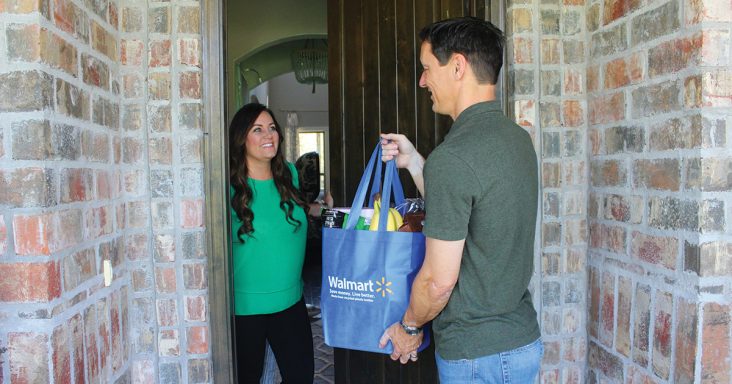The Supply Side: Walmart’s Spark delivery platform gaining momentum
by July 22, 2023 9:45 am 3,965 views

In its fifth year, Walmart's Spark delivery platform covers 84% of American households through 15,000 pickup points.
Walmart’s Spark delivery platform, which includes the GoLocal option, had 1 million deliveries last fall and continues to pick up steam. The proprietary delivery platform is similar to those used by Uber, DoorDash and Instacart.
According to Walmart, Spark tripled the number of pickup areas launched this year compared to last. Now in its fifth year, the Spark app covers 84% of American households through 15,000 pickup points. In addition to Walmart and Sam’s Club stores, the points include Walmart GoLocal clients such as Sally Beauty, Home Depot and American Auto.
A business can use GoLocal to deliver its products to customers without investing in the technology and equipment to provide the service. Walmart declined to give the number of GoLocal clients, revenue or operating income the segment generates.
SPARK DRIVERS
Demand to become Spark drivers remains high in Northwest Arkansas and other markets as more consumers want to become gig-economy workers. There were no openings in the Bentonville market as of early July.
Data from Gridwise indicates average hourly earnings for Spark Drivers was $24.10 between December 2022 and February 2023. Median pay was $23.70 per hour, with average weekly earnings of $323 based on 13 work hours. Drivers in the 90th percentile, who earned an average of $7,595 per week, put in about 31 work hours, Gridwise reported.
“Angie,” who asked for anonymity, spoke to the Northwest Business Journal about being a Spark Driver out of Store 100 in Bentonville. She previously worked in a retail store besides Walmart and was looking for a way to set her own hours and increase her earnings.
“I heard from a co-worker early this year about Spark as I was considering Instacart at the time,” she said. “I waited more than 2.5 months for an open position. I have been shopping and delivering from Walmart Store 100 since April. While I have not got it all figured out, I do work when I want, and I’m earning more money than in my full-time retail job.”
Angie said some drivers in Northwest Arkansas make $2,000 a week while working other jobs. She said the Spark app allows drivers to accept or decline an assignment. Orders vary from shopping for the items and delivery, just pickup and delivery or pickup and delivery for third-party retailers. She has chosen to focus solely on the shop and delivery option at Store 100 and says she stays busy.
Her typical day begins at 7 a.m. when she shops for at least one order. Sometimes, she said there are stacked orders, so she picks for two separate customers and then makes the deliveries. Then she repeats the process several times. Angie said demand typically dies off during mid-day, and she often signs in around 3 p.m. and works a few more hours. She validated the accuracy of the Gridwise data in the Northwest Arkansas market.
Gridwise reports that top earners in the Spark program range from $80,000 to $100,000 annually. However, they work 10 to 12 hours daily and receive incentive pay for taking stacked orders, traveling further for deliveries and referring friends to the program.
Angie said the best thing about being a Spark driver is the freedom and flexibility to increase earnings if needed and take time off.
“I will never go back to punching a time clock,” she added.
GROWING GoLOCAL
Walmart uses other delivery platforms in various markets but said that drivers on the Spark Driver platform have fulfilled nearly three-quarters of delivery orders. But the retailer continues to grow its GoLocal business.
“We continue to sign up larger-scale customers, and we’re making strides on the bigger unlock, which are small- and medium-sized businesses,” McMillon said earlier this year. “Our technology and expertise will help many of these businesses grow while contributing to our operating margins over time.”
GoLocal’s expansion coincides with Walmart’s push to grow different lines of business other than in-store sales. For example, Walmart has nearly doubled the coverage area of its InHome delivery service and is offering the white-glove service as an add-on to its Walmart+ membership service.
“We’re becoming more digital, even more relevant as an omnichannel retailer, and the related businesses like fulfillment and advertising continue to grow,” McMillon said.
While there is plenty of competition for third-party delivery services with DoorDash and Instacart, the most significant difference is that GoLocal doesn’t have a customer-facing platform. Instead, it focuses on delivering orders made on its clients’ websites and apps.
“That’s a big differentiator, to be respectful of not disintermediating business-to-consumer relationships,” said Harsit Patel, general manager of Walmart GoLocal.
Walmart said retailers using GoLocal notify the service when an order made through its app or website is ready to be delivered, along with the timeframe and any additional parameters. GoLocal offers delivery times as fast as 15 minutes, according to Patel. The service also can provide next-day delivery, but it’s not a fit for every business. Walmart is pushing into white-label delivery as other companies begin ramping up services outside the marketplace format.
Earlier this year, Walmart partnered with Salesforce to enhance the GoLocal delivery service.
“Retailers are looking for ways to improve cost efficiency while meeting their customers’ needs, no matter where or how they choose to shop,” Patel said. “Fulfillment from stores is an effective way to achieve these goals and serve customers quickly and reliably through local delivery. We look forward to connecting more retailers with the customizable, local delivery solutions they need.”
Editor’s note: The Supply Side section of Talk Business & Politics focuses on the companies, organizations, issues and individuals engaged in providing products and services to retailers. The Supply Side is managed by Talk Business & Politics and sponsored by Propak Logistics.
